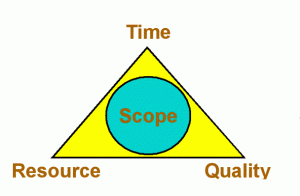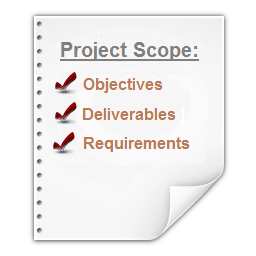Managing Scope for Project Success

Can you start a new project without having a clear scope statement? Perhaps, you can’t. The project scope management process is required to make a stable foundation for scope. Implementation of the process ensures project success. Project scope management is essential because it helps teams make scope unambiguous and carefully managed.
The process provides a formalized set of procedures for stating, executing, tracking and controlling scope. In this article we’ll focus on the goals and functions of the process. I hope the information written in the article will give a better understanding of project scope management and help you plan and do your projects more efficiently.
Goals
As a project manager, you need in collaboration with the sponsor and other stakeholders to establish the project scope management sample process throughout the project lifecycle to:
- Document a scope statement and communicate it to the sponsor and key stakeholders so they can review the document and conclude about what is in and out of the scope. Because it’s quite natural for different people to read the same documents and have different viewpoints, the project scope statement should be discussed before approval to avoid any misunderstandings. Project success will significantly depend on whether stakeholders have gained a shared understanding of the document’s details, including cost, schedule and deliverable-acceptance criteria.
- Monitor the project and make reviews to define an unexpected impact on the project scope management criteria. If the impact is identified and the criteria are changed in some way, you need to agree the changes with the sponsor and stakeholders and then document agreed decisions, so you’ll be enabled to demonstrate later that the changed scope meets quality standards of the project.
- Manage scope-related issues and make recommendations regarding scope improvement. Your project’s success depends on whether the issues are solved and appropriate changes to the scope and baseline initiation documents have been approved.
- Formalize approved changes to the scope statement and link the changes to the project management plan. In this context, the process focuses on making adjustments to the scope document and managing cost, schedule, deliverable-acceptance criteria which are elements of the plan.
Functions
These are the key goals of the project scope management sample process. Key participants of scope management (the project manager, the sponsor) will be involved in performing the process’s functions to set, monitor and control the scope throughout the project life-cycle. The functions are itemized below:
- Reviewing Project Charter Template and other project initiation documents (PID). The function of the project scope management activity is to identify and characterize scope elements and drivers for project success to create acceptance criteria for cost, schedule and deliverable and to state the scope baseline.
- Discussing the stated scope baseline with the sponsor and stakeholders. The function of the project scope management template activity aims to review data, assumptions and constraints to avoid any misunderstandings regarding the scope baseline and gain approvals of the scope statement.
- Addressing scope-related issues throughout the project life-cycle. Both the project manager and the team need to review scope elements and success drivers to identify any possible changes that may impact the scope baseline. Team leaders and executive staff should regularly review project scope management knowledge area throughout the project course for changes.
- Monitoring progress. The function of the sample project scope management process requires you to identify variances that are possibly caused by changes in scope.
- Processing scope change requests. To perform this function, you need in collaboration with the sponsor to agree a set of standard procedures for analyzing the impact of change requests on the project’s triple constraints and recommending alternative solutions for better change control.
- Updating the project management plan. This function of the project scope management example process refers to reviewing the approved changes to scope and then updating information (incl. the work breakdown structure (WBS), task lists, budgeting, procurement plans, communication plans) in the project management plan.
Your company involved in performing a project can establish the process for managing project scope considering the goals and functions. Project success will depend on the accuracy and efficiency of the company’s activities.
If the company doesn’t adequately manage the project constraints and review project progress, the project is likely to suffer from a negative impact of unplanned cost and schedule variances and then end up with failure. That’s why it’s important to establish an efficient project scope management process for reaching project success.














